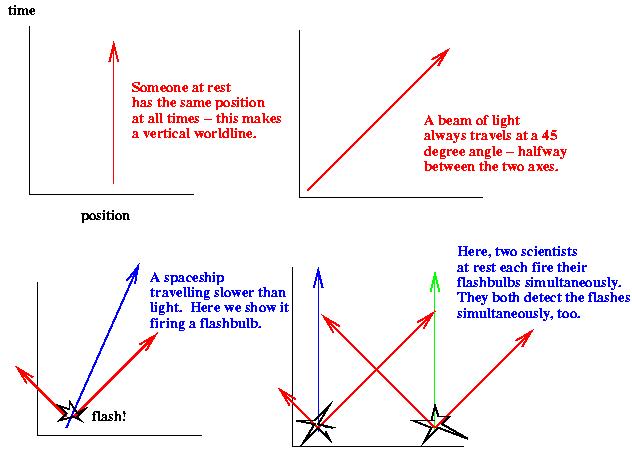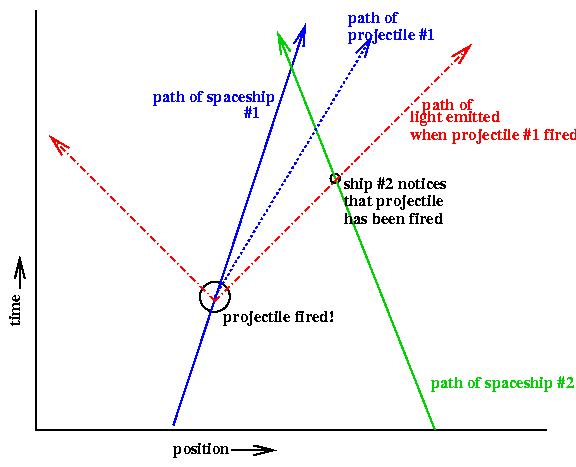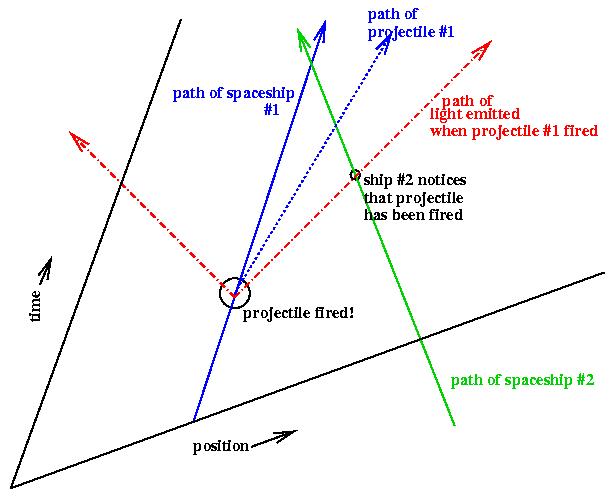
| MadSci Network: Physics |
Hello Scott,
The best way to answer these questions is to use something called a "spacetime diagram". To make this plot, you imagine all of your spaceships moving along a single line (like cars on a one-lane highway) rather than in two or three dimensions (like cars in a parking lot, or helicopters in the air). We'll plot POSITION of everything along the X axis. Then, we watch the system for some amount of time, and plot TIME on the Y axis. For every object moving through the system, it will trace out some line on this chart (called a "worldline"). Here are some examples:

Notice that we've picked the scales on the X and Y axes carefully: if you choose, say, "1 inch in Y = 1 year" and "1 inch in X = 1 light-year", it gives the chart an interesting property: "A beam of light always follows a path at a 45 degree angle" ... halfway between the X and Y axes. Anything moving slower than light will move along a "steeper" line; nothing can move along a shallower line, which would require moving MORE than 1 light year (in X) per year (in Y). And, I should point out the obvious, if two worldlines cross, it means that those two objects were in the SAME PLACE at the SAME TIME. Note that light is an object - you can't see something happen until some of its light hits you.
So with that in mind, here is a diagram of PART OF your scenario:

One step at a time: the two solid lines show the spaceships. I'm showing one of the spaceships firing a projectile (blue dotted line), which travels toward the other ship. The projectile is moving slower than light, so the light emitted during the launch (blue dot-dashed line) gets to the green ship before the projectile itself.
I hope this is clear? There is a lot going on in your question, so I only drew the first few lines. You can add more yourself: Perhaps the green ship would launch its own projectile when it saw the light from the blue ship's launch? You could draw this projectile as a green dotted line moving leftwards from the solid green line. It would of course intersect the blue dotted line, meaning that the two projectiles would collide. If the green ship doesn't launch right away, but waits for a moment, that means that you draw the green projectile's worldline starting a bit further up from the "detect enemy launch" event.
The REALLY cool thing about these diagrams is that you can re-draw them from the point of view of any observer. Remember, "sitting still" should ALWAYS correspond to a STRAIGHT, VERTICAL worldline. So, if your observer inside of Spaceship #1 wants to draw this diagram from his own perspective, he'd have HIMSELF traveling parallel to the Y axis. For our diagram, we can keep all of the worldlines in place but draw a new Y axis.
However, for any observer, the worldline of a light beam should be
halfway between the X and Y axes. So we also have to draw a new X
axis. So here's your diagram again, with the axes as drawn by
Spaceship #1.
 Note that the definition of "simultaneous" has changed! Any line parallel
to the new X axis represents "one instant of time" in the new observer's
frame. Note also that, from this new perspective, the blue projectile is
not traveling quite so fast, but the green ship is traveling very very
fast. But all of the same "events" (flashes, collisions, launches) occur
in the same way.
Note that the definition of "simultaneous" has changed! Any line parallel
to the new X axis represents "one instant of time" in the new observer's
frame. Note also that, from this new perspective, the blue projectile is
not traveling quite so fast, but the green ship is traveling very very
fast. But all of the same "events" (flashes, collisions, launches) occur
in the same way.
Anyway, I'm not really going to answer your question about exactly how the balls collide. However, I hope that you can draw your own spacetime diagram - or fill in more details on mine - and figure it out for yourself. If you want to try drawing a diagram, please email it to me (bmonreal@mit.edu), I would be happy to help you to correct and interpret it.
You might try reading this web page which explains the diagrams further. They should also figure prominently in any textbook on special relativity.
Hope this helps,
-Ben
Try the links in the MadSci Library for more information on Physics.